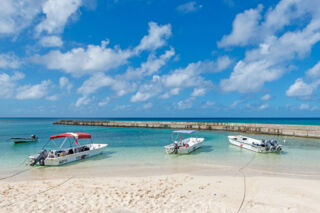Salt Cay Whale Watching
NOTE: This activity is only offered during the months of January, February, March, and April.
Annually during the winter season, humpback whales migrate from the northern Atlantic to warmer waters near the Caribbean. Typically originating from the vast waters surrounding north-western Europe, Greenland, Iceland, Canada, and from inside the Arctic Circle, the majority of whales head for a relatively small region near the Turks and Caicos and the Dominican Republic. The attraction of this region is a few shallow banks, which include the Silver Banks, Mouchoir Banks, and the Gentry Banks. The humpback whales make the long swim down to the Caribbean to give birth and to mate.
Whales can be spotted in the deep water off of the Caicos Islands, but the best place in the country for humpback whale watching is in the Turks Islands Passage near Grand Turk and Salt Cay.
The Turks and Caicos Islands are situated on a plateau that rises abruptly 10,000 feet (3048 m) from the ocean floor. This plateau is partially split by the 6,000-foot-deep (1830 m) Turks Islands Passage which separates the Turks Islands from the Caicos Islands.
Whales are naturally funneled through this channel, and the naturally increased density of whales makes Salt Cay and Grand Turk unrivaled sites for whale watching.
It’s often possible to see whale calves with their mothers, along with pods of five or more whales.
Male humpbacks sing a 10-20 minute complex and unique song, which can be heard for miles underwater. It’s not certain what this is for, but evidence suggests that it’s a mating call.
Whale Watching from Salt Cay
Unlike whale watching excursions offered at other destinations, smaller boats, often the same vessels used for diving and fishing expeditions, are the boats used for whale watching. Although they may not be as comfortable as a purpose-built larger vessel, such boats are often able to provide a closer view of the whales.
Snorkeling with Whales
Depending on the mood of the whales, the ocean conditions, and other factors, it may be possible to snorkel with the whales.
If the opportunity presents, we highly recommend taking advantage of it. An in-water encounter will be an unforgettable experience.
Guidelines
- Humpback whales are wild animals and thus may be unpredictable. Do not chase or closely approach whales.
- Wear snorkeling vests when in the water.
- As should be the practice with all animals, do not harass or disturb the whales.
Tour Companies



